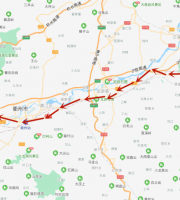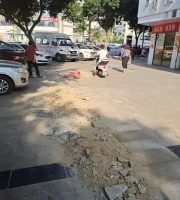Juhang construction machinery 2021-04-2710:55:00 bored pile: concept: it refers to the pile foundation formed by different drilling methods, forming a certain diameter well in the soil, lifting the reinforcement framework (cage) into the well and pouring concrete after reaching the design elevation
.
Main construction procedures: site preparation – casing embedding – mud preparation – Drilling – hole cleaning – reinforcement cage drilling – underwater concrete pouring, etc
.
1
.
Site preparation dry land: leveling and tamping site shallow water: building island deep water: fence method 2
.
Burying casing 1
.
The role of casing: fixing the position of pile hole, protecting the orifice, preventing the inflow of surface water, increasing the water pressure in the hole, preventing hole collapse, and guiding the direction of drill bit when forming the hole
.
2
.
The production requirements of the casing: ① the casing is usually made of reinforced concrete and steel, depending on the specific situation
.
The thickness of steel casing is 4 ~ 8mm, and that of reinforced concrete casing is 8 ~ 10cm
.
1-2 slurry overflow holes are set on the upper part of the casing
.
② The inner diameter of the casing is slightly larger than the designed diameter of the bored pile
.
The diameter of the hole drilled by rotary drilling rig should be increased by 20-30 cm; The diameter of the hole drilled with percussion drill and grab drill should be increased by 30-40 cm
.
3
.
The burying requirements of pile casing: (1) before drilling, set out and locate on site, excavate the surface soil of pile hole according to the pile position, and bury the pile casing
.
② The method of digging or hammering, vibration and pressurization can be used to bury the casing
.
③ The burial depth is generally 2-4m, and it should be deepened in special cases
.
④ The top elevation of the casing should meet the requirements of the water level setting height in the hole; 3
.
Mud preparation: mud skin is formed on the hole wall to stabilize the hole wall, suspend drilling slag, lubricate drilling tools and discharge slag in positive circulation
.
Composition and requirements: ① water: pH value of water is between 7 and 8, without impurities; ② Clay (or bentonite): plasticity index is more than 25, particle size is less than 0.005 mm, particle content is more than 50% of the total, relative density is 1.1-1.5; ③ Additives: inorganic: soda, etc
.
to promote the dispersion of particles, to prevent condensation subsidence
.
Organic: tannin solution, glue solution, etc
.
Bored pile for mud pit wall protection: instrument for mud index detection in mud pit 4
.
Requirements for drilling frame and drilling rig in place: 1
.
It can bear the weight of drilling tools and other auxiliary equipment, and has certain rigidity and enough height
.
② In the process of drilling, the hole center must be aligned with the pile center, and the drilling frame must be stable without displacement, inclination and subsidence
.
③ When the drilling frame is installed in place, it shall be measured in detail
.
The base shall be padded and plugged with sleepers, and the top shall be fixed stably with cable wind rope, and it shall be checked frequently during drilling
.
5、 Drilling: impact method, grab method and rotation method 1
.
Drilling bit of impact drill: cross shaped tubular cross bit
.
Construction points of impact drilling: start drilling after the adjacent hole concrete reaches 2.5MPa; Small stroke of opening; The hole depth is the normal impact after the stroke of high pressure heater
.
Medium and low stroke: 1-2m; cohesive soil, weathered layer, gravel, etc.; medium stroke: 2-3m; sand and gravel, etc.; equal high stroke: 3-5M; classification and expanding of bedrock, boulder and dense pebble layer; cross shaped drill bit drilling more than 1.5m; two grades of hole diameter; There are 2-4 stages for the hole with diameter more than 0.7m
.
2
.
Features of full casing punching and grabbing: no noise and vibration; No mud is used; Soil and lithologic characteristics can be identified directly during excavation, and the length of end bearing pile can be determined on site; The excavation speed is fast and the excavation depth is large; The perpendicularity is easy to master; The hole wall will not collapse and the quality of hole forming is high
.
The pile quality is high; The pore diameter is standard and the filling coefficient is very small; The hole cleaning is complete and fast; Self propelled, easy to move on site
.
There is a heavy iron block and a movable grabbing piece on the head of the punching and grabbing cone
.
The punching and grabbing cone is lifted to a certain height through the frame and the winch
.
When it falls, release the drum brake, the grabbing piece opens, and the cone head falls freely into the soil
.
Then start the winch to lift the cone head, and the grabbing piece closes to grab the soil
.
The punching and grabbing cone is lifted to the ground as a whole to unload the soil slag, and the hole is formed in turn
.
The construction process, installation requirements of casing and circulation of slurry wall protection are the same as those of impact drilling
.
It is suitable for punching in soft soil layer (sand and clay), but when encountering hard soil layer, it is suitable to use percussion drill instead
.
Full casing drilling 3
.
Positive circulation drilling
.
Positive circulation is to use mud pump to pump mud through the top of the hollow drill pipe at a certain pressure and eject it from the bottom of the drill pipe
.
When the drill cone at the bottom rotates, it will loosen the soil into drilling slag, which will be suspended by mud and overflow to the mud tank outside the hole with the mud rising
.
After sedimentation and purification in the sedimentation tank, it will be recycled
.
Features: the slag removal capacity is relatively weak, the drilling speed is slow, and the wear of drilling tools is relatively large, but the process is relatively simple, easy to operate, and the price of positive circulation drilling rig is relatively cheap
.
Application: clay, loam, muddy soil layer, silt, gravel layer and bedrock are used to form holes in positive and negative circulation
.
Now it is necessary to draw a cross line on the casing to align the drill bit of the drilling rig with the center line of the pile
.
After the alignment of the drilling rig, water is discharged into the casing and drilling is carried out with mud wall protection
.
The mud of the reverse circulation drilling rig circulates in the opposite way
.
The mud flows from the outside of the hole into the hole, and the drilling slag is sucked out from the top of the drill pipe through the center of the drill pipe by vacuum pump or other methods (such as air suction machine), or the slurry pump is drilled together with the drill cone, and the drilling slag is sucked out from the bottom of the hole
.
Features: the reverse circulation drilling rig has strong slag removal capacity, but the process is complex, improper operation is easy to cause hole collapse and buried drilling, and the price of reverse circulation drilling rig is relatively high
.
Application: same as positive circulation
.
The rotary drilling rig is mainly suitable for the construction of sandy soil, cohesive soil, silty soil and other soil layers
.
The maximum hole diameter can reach 1.5 ~ 4m, and the maximum hole depth is 60 ~ 90m, which can meet the requirements of various large foundation construction
.
The purpose of hole cleaning: during the drilling process, a part of mud and drilling slag will sink at the bottom of the hole
.
These sediments must be cleaned up, so that the poured concrete can be closely combined with the stratum or rock to ensure the bearing capacity of the pile
.
Methods: slurry extraction, hole cleaning, hole cleaning, slag removal, hole cleaning, circulating slag removal 7
.
Precautions for fabrication and installation of reinforcement cage: a 14-18 mm diameter reinforcing stirrup is generally set every 2-2.5 m for reinforcement framework; The reinforcement framework can be made in sections; The thickness of protective layer should be ensured; No matter what method is used in the transportation of reinforcement framework, the framework shall not be deformed; The reinforcement framework can be lifted by the rig tower, derrick or hoist, and slowly lowered to the design elevation in alignment with the casing center; The reinforcement framework shall be lowered to prevent collision with the hole wall; When the initial setting of the last poured concrete begins, the lifting ring of the reinforcement framework shall be cut immediately
.
Fabrication of reinforcement cage 1 fabrication of reinforcement cage 2 fabrication of reinforcement cage 3 alignment of lifting to hole position 2 welding of reinforcement cage 8
.
Grouting of underwater concrete slurry to protect the wall
.
The pouring of bored concrete is carried out in water or slurry, so it is called underwater concrete pouring
.
The underwater concrete should be a strength grade higher than the design strength, it must have good workability, and the mix proportion should be determined by test
.
Conduit method is commonly used in underwater concrete pouring
.
When pouring, first fill the conduit and funnel with concrete, try to ensure that the lower end of the conduit is buried more than 0.8m below the concrete surface at one time, and then cut the steel wire hanging the water cock, and the concrete mixture will be discharged into the water quickly under the self weight
.
Underwater concrete pouring process: pouring underwater concrete can not directly pour the concrete into the water
.
Because when the concrete directly contacts with water and passes through the water layer, the aggregate and cement will be separated soon, and the aggregate will sink into the bottom quickly, while the cement will be suspended for a long time
.
When it sinks, it has set and hardened.
.



